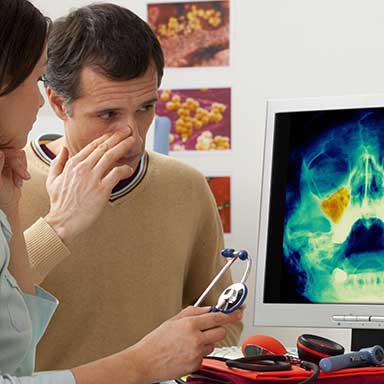Throat Conditions

Sore Throat
A sore throat can occur for a number of reasons. Bacterial or viral infection can create pain when swallowing, scratchiness or itchiness, hoarseness, or overall throat discomfort. Breathing through your mouth consistently or if the air around you has little to no humidity, the resulting dryness can also cause a sore throat. Sore throats may also result from gastro esophageal reflux disorder, due to repeated exposure to stomach acid. However, if your sore throat is recurrent or if you suffer from chronic tonsillitis, you may want to have your tonsils evaluated.
Tonsillitis
The tonsils are two patches of lymphatic tissue located in the back of the throat. They’re easily viewed if you point a light toward the back of your mouth. When your tonsils function correctly, they filter bacteria and other toxins from the body. However, sometimes tonsils become chronically infected and are no longer helpful to the body. If you have these conditions frequently like sore throats, episodes of strep throat or tonsillitis, enlargements of the tonsils that interfere with swallowing and breathing, or production of pustules better known as “tonsil stones,” your tonsils may no longer be good for you.
Removing your tonsils will not impact your immune system negatively or decrease your ability to combat illness. In fact, chronically infected tonsils are a source of ongoing illness, and many patients find themselves feeling healthier and stronger after infected tonsils are removed.
Enlarged Adenoids
Similar to your tonsils, the adenoids are composed of lymphatic tissue that helps to prevent infection. Unlike the tonsils, however, they can’t be seen or evaluated by simply opening your mouth, because they’re located higher up and behind the nose. If your adenoids become chronically infected or enlarged, you could have trouble breathing, snore, or develop ear infections. Your adenoids can be evaluated by X-ray or during a tonsillectomy and subsequently removed if necessary.
Difficulty Swallowing (Dysphagia)
Many factors can cause difficulty swallowing, which in turn can result in many complications. If you find yourself avoiding certain foods because it’s increasingly difficult to swallow, experiencing pain while swallowing, or losing weight because of these or other difficulties, see a doctor.
Dysphagia condition can be evaluated through a laryngoscopy, a study called a “Barium Swallow,” or other imaging tests such as an X-ray or CT scan. Your physician can determine whether your symptoms are originating in the esophagus or oropharynx or if the problems are neurological. Once the cause is identified, a treatment plan can be set in place to treat and hopefully resolve these difficulties.

Head and Neck Cancer
The different types of head and neck cancer can occur in the following areas: the oral cavity, the pharynx (including the oropharynx, nasopharynx, and hypopharynx,) the larynx, and the paranasal sinuses (including the nasal cavity and salivary glands). These cancers conditions typically occur in the squamous cells, those that form the mucosal linings of tissues included in the head and neck. If they begin to grow irregularly, they can form squamous carcinomas. Tobacco and alcohol use are the two most common risk factors associated with head and neck cancers. The National Cancer Institute outlines common symptoms here. If you feel you may be at risk for head or neck cancer, follow up with a physician for further evaluation.
Esophageal Reflux
There are several factors that could cause esophageal reflux, including overproduction of acid and over-relaxation of the lower esophageal sphincter. If your esophagus is repeatedly exposed to acid, the esophageal lining can become inflamed and cause bothersome symptoms. Some people experience a burning sensation in the chest, but since not everyone does, patients don’t often think that this symptom indicates reflux at all. Other symptoms can include chronic hoarseness, chest pain, a chronic dry cough, or the sensation that there’s a lump in the back of your throat.
Esophageal reflux condition can be diagnosed based on your symptoms or through a procedure called a direct laryngoscopy. Dr. Wandzel will insert a flexible fiberoptic scope through your nose and down into your throat. This short procedure can be used to evaluate the adenoids, arytenoids, base of the tongue, and epiglottis for irritation from acid. If esophageal reflux is diagnosed, many over-the-counter or prescription medications can decrease acid production and treat symptoms.
